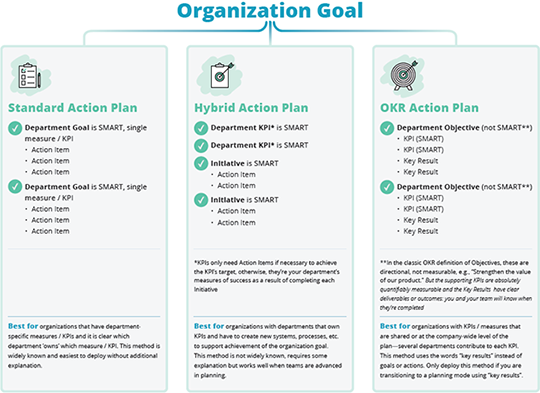We know that it feels like it’s time to celebrate when your company goals are completed; they’ve addressed your strategic questions, each goal has a clear outcome with annual targets, the owner has been assigned accountability—you’re ready to implement, right? Maybe.
While clear and measurable company goals are essential to achieving your organization’s vision, those goals should be made actionable through the departments’ goals that cascade from the company-wide goals—let’s call this part of your goal cascade the Action Plan. This is how your teams know what they must do to contribute to the successful achievement of each company-wide goal. Don’t get nervous! Get working on your Action Plans with one of the three approaches we know work to keep teams engaged and clear on what they must do.
But first, a reminder on the foundation of successful Action Plans: a GREAT company goal defines the “WHAT” an organization must achieve:
- They express outcomes in a tangible and unambiguous way (it will be very clear when the goal is achieved)
- They provide clear value for the organization (articulate why it matters to the organization)
- They may take a year or longer to achieve, but they’re SMART (Specific, Measurable, Attainable, assign Responsibility, are Time bound)
An example of a great, SMART goal:
Want to know more about SMART goals? Check out this handy, free Guide.
Next, Action Plans define HOW the company goal will be accomplished and how each department and individual will contribute. Before you send your functional teams off to build their Action Plans, decide on a structure for every department to follow. We use one of three approaches to action planning:
Pro Tips
- Not every department supports every company goal! Once your company goals are established, identify which departments must contribute—then they’ll know which goals they’re action planning for.
- Consider Action Plans to be a department’s annual plan. Building 3-year Action Plans is going to be frustrating if they need to be revised annually. Keep your teams focused on how they’ll deliver in the next 12 months.
- Department Goals / KPIs should be assigned an owner who is accountable for its achievement, even if different individuals are assigned ownership of the supporting Action Items.
- Initiatives, Key Results and Action Items should each start with an action verb (e.g., create, design, launch) because these action verbs are part of what conveys the deliverable or result (e.g., “Create a database of past 2 years’ lapsed customers to market new service contracts to.”). If your first verb is something like, “maintain” or “strive” or “continue”, you’ve just described an activity, which is your day job and should not be part of your Action Plan—keep doing your day job to keep the current status functioning but focus your Action Plan on the new deliverables or outcomes.
- Remember, effort initiatives are absolutely measurable! While they may not have a quantifiable outcome (like number of gizmos sold) as long as they concisely and clearly define an outcome so that everyone knows when the initiative is successfully completed or operational, you can measure progress in terms of percent complete. If an initiative is, “Establish a standard system for processing returns so that every return is processed the same way,” think of measuring in terms of key milestones: 25% complete would be the audit of current processes is complete; 50% complete would be design of standard process is complete; 75% complete would be training on new standard process begins.
We think of Action Plans as where the rubber hits the road: they spell out the commitment each department makes to the organization goals and they keep the third or fourth level in your organization chart engaged and focused on what must be done to achieve the Vision. By providing both clear organization goals and a simple structure to follow for action planning, you’ll set your teams up to feel a tremendous amount of ownership and keep them on track, which we know is how organizations achieve their vision!
P.S. Many of our clients come to us half-way through their planning process: they’ve completed their Vision, Strategic Objectives and Organization Goals (what we consider the plan’s framework), but they haven’t made the plan actionable or they’re not sure how to cascade to the next levels in their organization. We’ve designed a simple, but effective method for guiding your teams through action planning, so let us know if you’re stuck and would like our support to finish your plan and connect your teams to how they’ll contribute to your big, bold vision.












